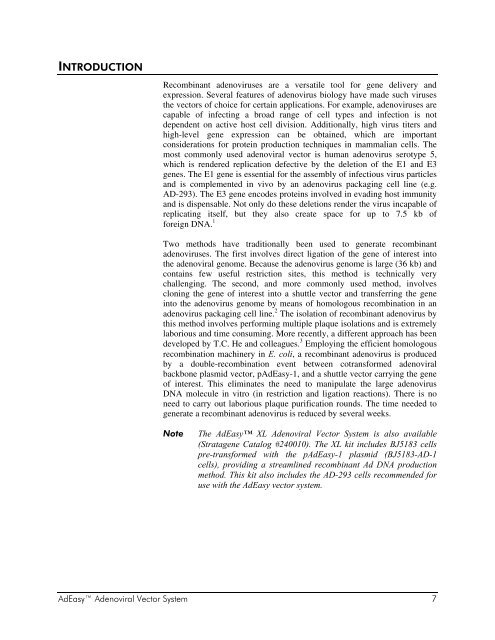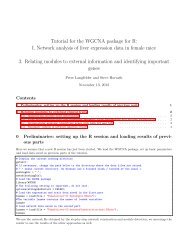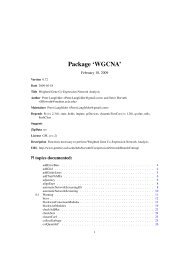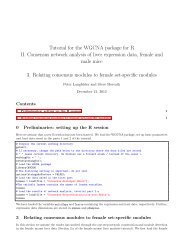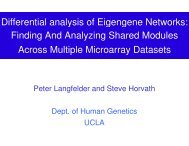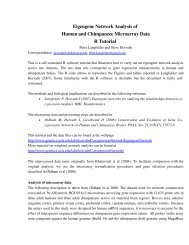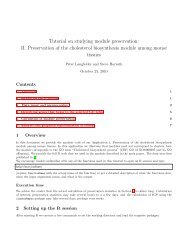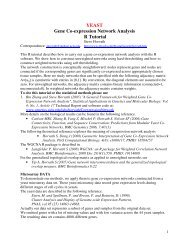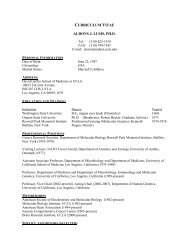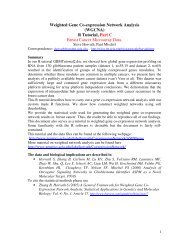Manual: AdEasy Adenoviral Vector System - UCLA Human Genetics
Manual: AdEasy Adenoviral Vector System - UCLA Human Genetics
Manual: AdEasy Adenoviral Vector System - UCLA Human Genetics
You also want an ePaper? Increase the reach of your titles
YUMPU automatically turns print PDFs into web optimized ePapers that Google loves.
INTRODUCTION<br />
Recombinant adenoviruses are a versatile tool for gene delivery and<br />
expression. Several features of adenovirus biology have made such viruses<br />
the vectors of choice for certain applications. For example, adenoviruses are<br />
capable of infecting a broad range of cell types and infection is not<br />
dependent on active host cell division. Additionally, high virus titers and<br />
high-level gene expression can be obtained, which are important<br />
considerations for protein production techniques in mammalian cells. The<br />
most commonly used adenoviral vector is human adenovirus serotype 5,<br />
which is rendered replication defective by the deletion of the E1 and E3<br />
genes. The E1 gene is essential for the assembly of infectious virus particles<br />
and is complemented in vivo by an adenovirus packaging cell line (e.g.<br />
AD-293). The E3 gene encodes proteins involved in evading host immunity<br />
and is dispensable. Not only do these deletions render the virus incapable of<br />
replicating itself, but they also create space for up to 7.5 kb of<br />
foreign DNA. 1<br />
Two methods have traditionally been used to generate recombinant<br />
adenoviruses. The first involves direct ligation of the gene of interest into<br />
the adenoviral genome. Because the adenovirus genome is large (36 kb) and<br />
contains few useful restriction sites, this method is technically very<br />
challenging. The second, and more commonly used method, involves<br />
cloning the gene of interest into a shuttle vector and transferring the gene<br />
into the adenovirus genome by means of homologous recombination in an<br />
adenovirus packaging cell line. 2 The isolation of recombinant adenovirus by<br />
this method involves performing multiple plaque isolations and is extremely<br />
laborious and time consuming. More recently, a different approach has been<br />
developed by T.C. He and colleagues. 3 Employing the efficient homologous<br />
recombination machinery in E. coli, a recombinant adenovirus is produced<br />
by a double-recombination event between cotransformed adenoviral<br />
backbone plasmid vector, p<strong>AdEasy</strong>-1, and a shuttle vector carrying the gene<br />
of interest. This eliminates the need to manipulate the large adenovirus<br />
DNA molecule in vitro (in restriction and ligation reactions). There is no<br />
need to carry out laborious plaque purification rounds. The time needed to<br />
generate a recombinant adenovirus is reduced by several weeks.<br />
Note<br />
The <strong>AdEasy</strong> XL <strong>Adenoviral</strong> <strong>Vector</strong> <strong>System</strong> is also available<br />
(Stratagene Catalog #240010). The XL kit includes BJ5183 cells<br />
pre-transformed with the p<strong>AdEasy</strong>-1 plasmid (BJ5183-AD-1<br />
cells), providing a streamlined recombinant Ad DNA production<br />
method. This kit also includes the AD-293 cells recommended for<br />
use with the <strong>AdEasy</strong> vector system.<br />
<strong>AdEasy</strong> <strong>Adenoviral</strong> <strong>Vector</strong> <strong>System</strong> 7


